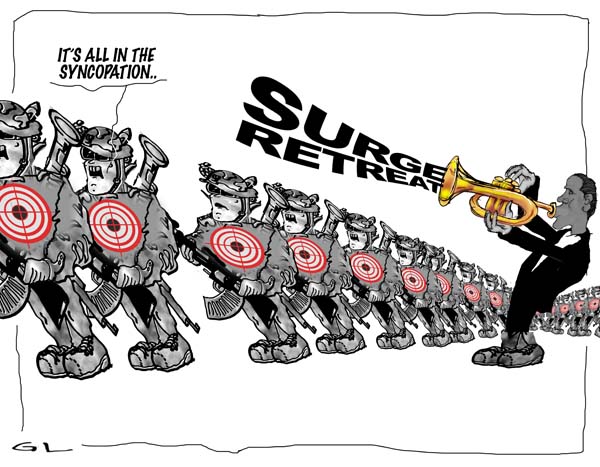Search
Recent comments
- a role to play....
2 hours 34 min ago - hitlerite lies....
7 hours 11 min ago - ignoring....
9 hours 35 min ago - antisemitismus
12 hours 24 min ago - trust me.....
13 hours 54 min ago - WATCH again.....
14 hours 18 min ago - pedo-zionists....
14 hours 43 min ago - silently....
15 hours 14 min ago - khatyn....
1 day 1 hour ago - criminal....
1 day 4 hours ago
Democracy Links
Member's Off-site Blogs
syncopation...

How Obama Came to Plan for ‘Surge’ in Afghanistan
By PETER BAKER
WASHINGTON — On the afternoon he held the eighth meeting of his Afghanistan review, President Obama arrived in the White House Situation Room ruminating about war. He had come from Arlington National Cemetery, where he had wandered among the chalky white tombstones of those who had fallen in the rugged mountains of Central Asia.
How much their sacrifice weighed on him that Veterans Day last month, he did not say. But his advisers say he was haunted by the human toll as he wrestled with what to do about the eight-year-old war. Just a month earlier, he had mentioned to them his visits to wounded soldiers at the Army hospital in Washington. “I don’t want to be going to Walter Reed for another eight years,” he said then.
The economic cost was troubling him as well after he received a private budget memo estimating that an expanded presence would cost $1 trillion over 10 years, roughly the same as his health care plan.
Now as his top military adviser ran through a slide show of options, Mr. Obama expressed frustration. He held up a chart showing how reinforcements would flow into Afghanistan over 18 months and eventually begin to pull out, a bell curve that meant American forces would be there for years to come.
“I want this pushed to the left,” he told advisers, pointing to the bell curve. In other words, the troops should be in sooner, then out sooner.
When the history of the Obama presidency is written, that day with the chart may prove to be a turning point, the moment a young commander in chief set in motion a high-stakes gamble to turn around a losing war. By moving the bell curve to the left, Mr. Obama decided to send 30,000 troops mostly in the next six months and then begin pulling them out a year after that, betting that a quick jolt of extra forces could knock the enemy back on its heels enough for the Afghans to take over the fight.
- By Gus Leonisky at 7 Dec 2009 - 10:26am
- Gus Leonisky's blog
- Login or register to post comments
at peace...
Mr. Obama then went to the Situation Room to call General McChrystal and Ambassador Eikenberry. The president made it clear that in the next assessment in December 2010 he would not contemplate more troops. “It will only be about the flexibility in how we draw down, not if we draw down,” he said.
Two days later, Mr. Obama flew to West Point to give his speech. After three months of agonizing review, he seemed surprisingly serene. “He was,” said one adviser, “totally at peace.”
------------------
Decision made... "good for you" Bertha would say... as Zippy defers a disastrous outcome...
see toon at top.
war forever...
Written by Chris Floyd
Thursday, 03 December 2009
"How does it become a man to behave toward this American government to-day? I answer that he cannot without disgrace be associated with it." -- Henry David Thoreau
To me, this quote from Thoreau expresses the only rational, moral and humane stance that a citizen can take toward the vast and brutal machinery of the American imperial state in our time. The crimes of this state are monstrous, and mounting. But what is worse is that these crimes are not aberrations; they are the very essence of the system -- they are its goal, its product, its lifeblood.
And what is this crimeful essence? Matt Taibbi described it well in a recent article:
Our Western society quite openly embraces war as a means of solving problems, and for quite some time now has fashioned its entire social and economic structure around the preparation for war.
I believe this is an indisputable fact.
------------
see toon at top...
war and hatred...
Chris floyd quoting Patrick Cockburn
The Obama plan outlined last week envisages training 100,000 new Afghan soldiers and 100,000 new policemen over the next three years. But where are these recruits to come from? Given the high desertion rate, the combat strength of the Afghan army is reportedly only 46,000 troops in a country that is larger than France. These troops, and particularly the officer corps, are already disproportionately Tajik, the ethnic group to which a quarter of Afghans belong. The US can only increase the military strength of the Afghan state swiftly by skewing it towards the Tajiks, who were always the core of opposition to the Taliban. This will increase sectarian hatreds.